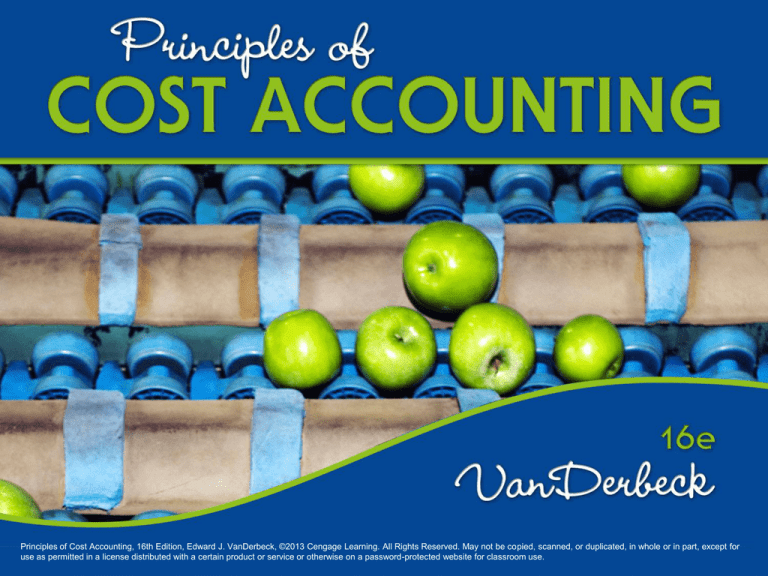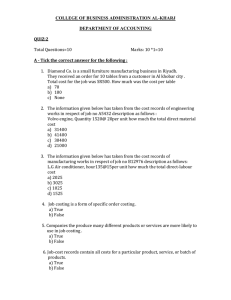
Principles of Cost Accounting, 16th Edition, Edward J. VanDerbeck, ©2013 Cengage Learning. All Rights Reserved. May not be copied, scanned, or duplicated, in whole or in part, except for
use as permitted in a license distributed with a certain product or service or otherwise on a password-protected website for classroom use.
Chapter 10
Cost Analysis for
Management Decision Making
Learning Objectives
Compute net income under variable and
absorption costing.
Discuss the merits and limitations of
variable costing.
Define segment profitability and
distinguish between direct and indirect
costs.
Learning Objectives (cont.)
Compute the break-even point and the
target volume needed to earn a certain profit.
Calculate the contribution margin ratio and
the margin of safety ratio.
Discuss the impact of income tax on breakeven computations.
Use differential analysis to make special
decisions.
Learning Objectives (cont.)
Identify techniques for analyzing and
controlling distribution costs.
Variable and Absorption
Costing
• Under variable costing the cost of a
manufactured product includes only the costs
that vary directly with volume: direct materials,
direct labor, and variable factory overhead.
• Absorption costing includes both fixed and
variable manufacturing costs are assigned to
the product and no particular attention is
given to classifying the costs as either fixed or
variable.
Variable and Absorption
Costing
Variable and Absorption
Costing
Merits and limitations of
Variable Costing
• Some managers believe that variable
costing helps management planning
because it presents a clearer picture of
how changes in production volume affect
costs and income.
• However, it is not a generally accepted
method of inventory costing for external
reporting purposes.
Merits and limitations of
Variable Costing
• Variable costing matches only the variable
manufacturing with revenue.
• Prohibited by the Internal Revenue
Service in computing taxable income.
• Also criticized because no fixed factory
overhead cost in included in work in
process or finished goods inventories.
Segment reporting
• A segment may be a division, a product
line, a sales territory, or other identifiable
organizational unit.
• Segment profitability analysis requires that
all costs be classified into one of two
categories:
• Direct (traceable)
• Indirect ( nontraceble)
CVP Analysis
• Cost-volume-profit analysis is a technique
that uses the degrees of cost variability to
measure the effect of changes in volume
on resulting profits.
• Break-even point is the point at which
sales revenue is adequate to cover all
costs to manufacture and sell the product
but not enough to generate any profit.
CVP Analysis
• Contribution margin is determined by
subtracting variable costs from sales
revenue; it represents the amount
available to cover fixed costs and earn a
profit.
Break Even Analysis
Break Even Analysis
Contribution Margin Ratio &
Margin of Safety
• Contribution margin ratio =
Contribution Margin
Sales
• The margin of safety indicates the amount
that sales can decrease before the
company will reach break even; it may be
expressed in unit or dollar sales.
Impact of income tax on
Break –Even Point
• Income tax affects the number and dollar
amount of units that must be sold to earn
a certain amount of after-tax net income.
• Pretax income =
After-tax income/1- Tax Rate
Differential Analysis
• A study that highlights the significant cost
and revenue data alternatives is referred
to as differential analysis.
• The amount of the extra profit earned from
choosing the better if the alternatives is
known as differential income.
• Many companies follow the practice of
contribution pricing.
Distribution Costs
• Distribution costs include the costs
incurred to sell and deliver the product.
• Businesses devote considerable amount
of time attempting to answer the questions
such as:
“ How much of the total truck expense is
chargeable to each sale?”
“ Should it be allocated on the basis of the
time spent at each stop by the driver?”





